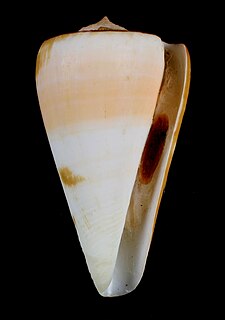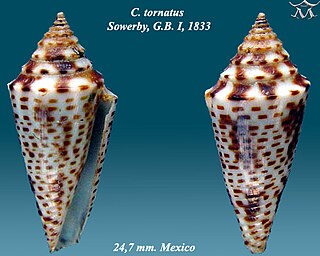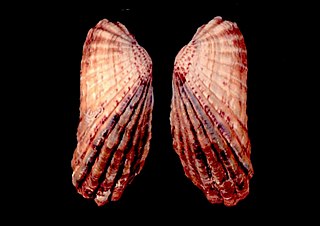Cardita is a genus of marine bivalve molluscs in the family Carditidae.

Conus diadema, common name the diadem cone, is a species of sea snail, a marine gastropod mollusk in the family Conidae, the cone snails and their allies.
Conus dispar is a species of sea snail, a marine gastropod mollusk in the family Conidae, the cone snails and their allies.

Conus fergusoni, common name the Ferguson's cone, is a species of sea snail, a marine gastropod mollusk in the family Conidae, the cone snails and their allies.

Conus purpurascens, common name the purple cone, is a species of sea snail, a marine gastropod mollusk in the family Conidae, the cone snails and their allies.

Conus regularis, common name the regular cone, is a species of sea snail, a marine gastropod mollusk in the family Conidae, the cone snails and their allies.

Conus tiaratus, common name the tiara cone, is a species of sea snail, a marine gastropod mollusk in the family Conidae, the cone snails and their allies.

Conasprella tornata, common name the grooved cone, is a species of sea snail, a marine gastropod mollusk in the family Conidae, the cone snails and their allies.

Crassispira incrassata, common name the thickened pleurotoma, is a species of sea snail, a marine gastropod mollusk in the family Pseudomelatomidae.

Crassispira nigerrima, common name the jet-black pleurotoma, is a species of sea snail, a marine gastropod mollusk in the family Pseudomelatomidae.

Crassispira turricula, common name the turriculated pleurotoma, is a species of sea snail, a marine gastropod mollusk in the family Pseudomelatomidae.

Carditamera is a genus of molluscs in the family Carditidae.

Fissurella macrotrema is a species of sea snail, a marine gastropod mollusk in the family Fissurellidae, the keyhole limpets and slit limpets.

Fissurella microtrema, common name the rugose slit limpet, is a species of sea snail, a marine gastropod mollusk in the family Fissurellidae, the keyhole limpets and slit limpets.

Fissurella virescens, common name the green Panama keyhole limpet, is a species of sea snail, a marine gastropod mollusk in the family Fissurellidae, the keyhole limpets and slit limpets.

Modiolus capax, common name fat horsemussel, is a species of "horse mussel", a marine bivalve mollusc in the family Mytilidae, the mussels. It was first described to science by American malacologist Timothy Abbott Conrad in 1837.. The type specimen was collected in San Diego by Thomas Nuttall.

Axinactis inaequalis is a species of bivalve mollusc in the family Glycymerididae.

Barbatia reeveana, the low-rib ark or common Reeve's ark, is a species of bivalve mollusc. It was first described to science by Alcide d'Orbigny in 1846. It seems likely that the species is named for Lovell Augustus Reeve, an eminent conchologist of the day who was mentioned in d'Orbigny's original description of the species.

Codakia distinguenda, the elegant lucine, is a species of marine bivalve mollusc. It was first described to science in 1872 by George Washington Tryon Jr.

Megapitaria squalida, the chocolate clam, is a species of bivalve mollusc in the family Veneridae. It was first described to science by George Brettingham Sowerby, a British conchologist, in 1835. The type specimen was collected by Hugh Cuming.

















